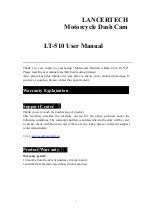
V1.02
Thom Hogan’s Complete Guide to the Nikon D300
Page 688
makers use different designations for the filter point. Here’s a
table of some of what’s available:
Filter
Cutoff
Manufacturers
RG 610
610 nm Heliopan
RG 630
630
Heliopan
RG 645
645
Heliopan
RG 665
665
Heliopan
RG 695
695
Heliopan
89B,BW092
710
Kodak, B&W, others
RG 715
715
Heliopan
88A
Kodak,
others
87,RG 780
780
Heliopan, Kodak, others
87C,RG830,BW093 830
Heliopan,
B&W,
Kodak
RG 850
850
Heliopan
RG 1000
1000
Heliopan
Tip:
If you want the false-color infrared associated with Kodak’s
near-infrared slide films, you can use another technique:
stack polarizing filters!
If you’re an infrared junkie, you probably would like to get rid
of the hot mirror filter over the sensor and replace it with a
visible spectrum blocker (like the above filters). This would let
you use the camera almost normally, but the camera would
always
take near IR pictures instead of visible light pictures
(i.e. once converted, the camera isn’t usable for normal
photography).
Well, if you want to throw caution to the wind, you can make
such a modification, but note that this is major surgery and,
done incorrectly, will render your D300 useless. Fortunately,
there are companies that offer a modification service, most
notably
http://www.lifepixel.com
and
http://www.maxmax.com
. I had one of my D70’s converted
this way by Life Pixel, and carry this extra body with me when
I want to do infrared photography. Here’s what a picture
taken with my converted camera looks like:
















































